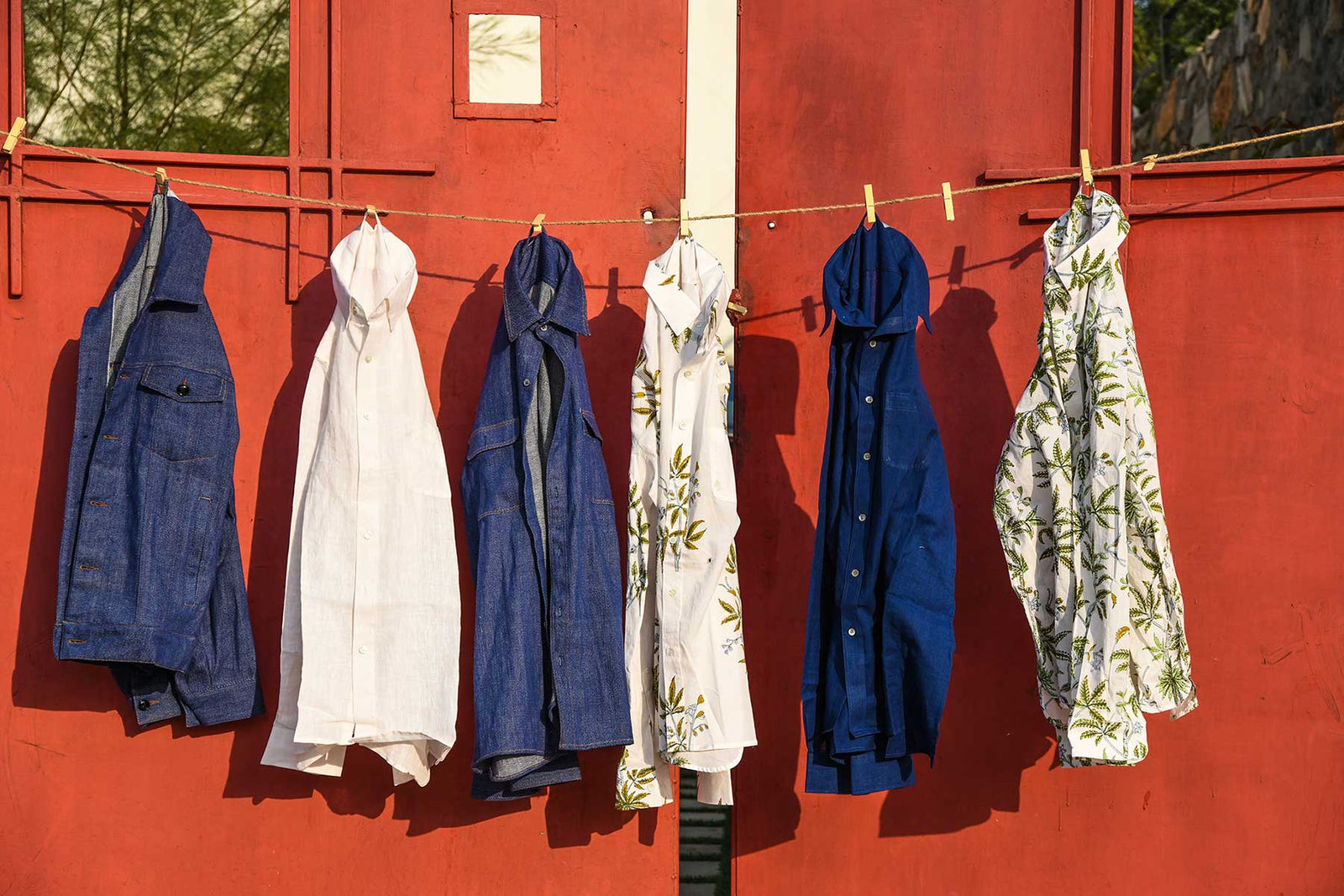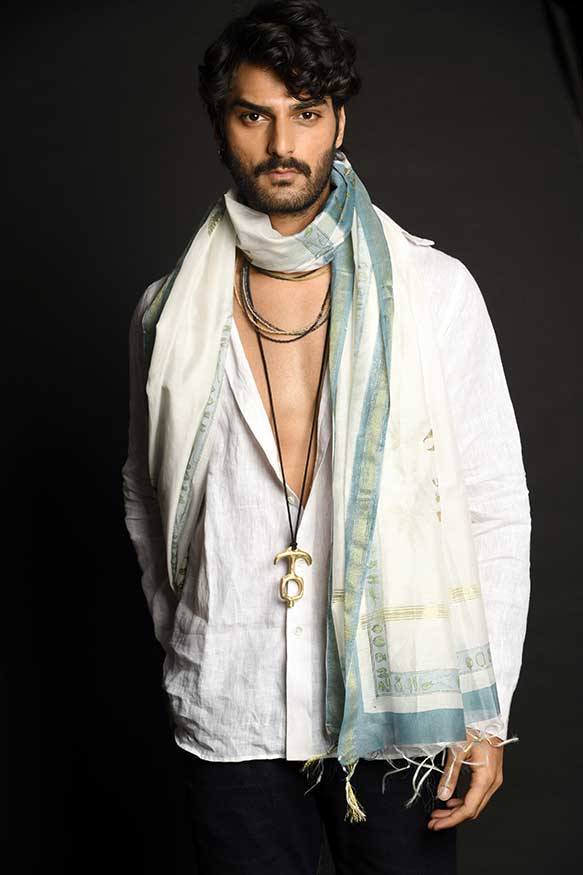“We proceed as if not agriculture and handicraft, but reading and writing were the beginning of civilization.”
- Albert Schweitzer
Why Do Consumers Treat Crafts as Commodities?
Hint—It Isn’t Their Fault
We think about crafts as beautiful, vanishing cultures at the margins of the Indian economy. It is a romantic vision of generational skills, but also destructive to those engaged in actual making. Regarding makers as noble amidst struggle is a nice tribute. However, it doesn’t feed makers, educate their kids or ensure that these artforms live into the future. Crafts nostalgia is frozen in an older business environment that disregards potential cultural and economic losses melting away each day that goes by without a real strategy.
But, there’s some good news. New drivers could make crafts central to the rise of, by some estimates, 200 million Indians.1 We believe crafts are a source of experiential tourism, key to sustainable Big Fashion, a propellent for India’s UN Sustainable Development Goals, vital to the success of Make in India and a tide that could lift all boats. Crafts need a strategy. We believe the problem is that in the absence of other information, consumers view crafts as commodities with commodity pricing. Let’s explore what moving from commodity pricing toward information-driven differentiation and a focus on quality looks like.
Consumers, climate change and technology are driving the new opportunities. Specifically, the pandemic pushed international consumer preferences towards Environmental, Social and Governance (ESG) dimensions faster than projected. Simultaneously, Blockchain-style technologies are making operations management simpler, cheaper and more accessible to craft makers. Innovation means makers have paths towards international standards of fabrication and business processes demanded by export customers. Domestic retailers will like more predictable order fulfilment, too.
All signs point towards changed global consumers who will support a vision of craft similar to royal patronage artforms used in the past. These consumers want and are willing to pay for sustainability, the absence of oppression and handmade (vs. AI-driven-robot-made) goods. They give bonus points for story and supply chain transparency.
Currently, Artificial Intelligence-driven manufacture is making handmades even rarer and more valuable. In the EU and USA, 65% of customers identify ESG dimensions as one of the top two purchase considerations.2
Structural Analysis of the Crafts Sector
Let’s look at structural dynamics that hurt everyone in the sector and a framework for how India’s makers can prosper from the new opportunities. Post-colonial theory may explain causation and more research is necessary, but the logic is sound and verified by the strategy departments of every large, Indian public company. We’re saying this kind of industry structural analysis may be new to many readers, but the tools aren’t new.
Consumers See Crafts as Commodities
Crafts and craftsmen are vibrant, creative stewards of culture. However, most consumers see craft output as fungible and uniform. In other words, customers can’t see how blue cloth woven out of Kala cotton by fine makers is any different than blue cloth from commercial yarns and unskilled hands. The situation is understandable since few of us can identify specialization, story, grade, or a recognizable hand unless a trustworthy source tells us so.
In the absence of trustworthy information, goods become interchangeable commodities. There isn't even general agreement on basic definitions. Interchangeability means craft output is priced as a commodity, when craft make is anything but that, except on the most basic terms of functional use. This is how consumer perceptions drive the sector towards a commodity pricing model. Price is the only driver they can discern.
If crafts are priced as commodities, the lowest cost producers win the most customers. In a commodity pricing model authenticity reduces either profitability or sales volume because it adds cost layers. Why would makers do the true thing unless they can get paid for the extra efforts? They can’t. Misaligned incentives, which prioritize low-cost production, crush makers and the artforms themselves.


The Crafts Sector is Functionally Broken and Needs Amelioration
The Indian government declared handicrafts a sunset sector to make way for higher-value jobs. Few will argue that handmades are a hard industry all around; or that India should aim for a higher value future. It should. Yet, the decision to sunset handmades is a strategic mistake that arises out of a fundamental economic misunderstanding. Doing nothing, or worse, sunsetting handmades destroys value, lives, India’s intangible culture; importantly, sunsetting misses out on huge, near horizon opportunities. A sunset mistake now precludes a future when AI and sustainability-driven consumer preferences are likely to make handicrafts and heritage raw materials more highly desired than at any time since industrialization. Crafts aren’t a sunset. They’re a bridge.
Instead of surrendering to sunset, let’s ask how things can change to capture more value for everyone. How can we transform the crafts sector into economically functioning markets built for how consumers shop today?
Crafts Fail the Definition of a Functioning Market
Functioning Markets
In classical economics, there are five elements of a functioning market. (See infographic). If we agree that it is desirable to develop fair competition as the surest path to market-driven innovation and efficiency, then we must care that crafts exist in functioning markets. Today, crafts fail on four out of five definitions of functioning market. Fortunately, the answer lies in the problem.
Let’s define economically functioning markets as interconnected, responsive networks of institutions, individuals, and social arrangements. Collectively, these networks drive toward seamless, low-cost transactions. In other words, functioning markets create the circumstances for healthy competition.
For instance, Biotech and BPOs are highly functional sectors in India. In Biotech and BPOs, there are enough international buyers and domestic suppliers to generate a collective increase in value. That’s the goal: healthy industries increase overall value so there is more to share among stakeholders. Handmades, conversely, are so unbalanced as to erode overall value, especially for the makers.
Why Markets Fail
Markets fail when uncertainty around transactions raises costs beyond the benefits of the exchange. A simple Five Forces analysis shows that the Bargaining Power of Suppliers (the artisans and raw materials makers) is too low; Bargaining Power of Buyers (middlemen and brands) is too high; Threat of New Entrants (new artisans and raw material makers) is medium and Threat of Substitutes is high. 3 These forces indicate makers have very low bargaining power. Too low. The collective strength of these forces determines an industry’s profit potential. The overall market suffers because makers suffer. Amelioration would lift all boats.
Viewed objectively, handicrafts are highly differentiated artforms, which are the opposite of commodities. Why don’t we regard them that way? Seemingly immovable forces on Suppliers create uncertainty that breaks market function. Un-breaking the sector requires moving away from a commodity pricing model towards a differentiated pricing model. How can that happen?

Bargaining Power of Suppliers and Buyers
Artisans have very low power because they live, mostly, at subsistence, which diminishes their access to defensive tools. Handicraft makers and fans need to 1) analyze the forces impacting their livelihoods 2) clarify where strategic changes will yield the biggest payoffs and 3) make defensive moves against the stronger, market forces. The theory is complex but taking the necessary actions is simple.
The infographic reveals that the biggest opportunities for change are Information and Externalities. Let’s focus here. The trick with strategy is to identify what you can do right now without too much more money, skills or time to capture value that creates the resources to move further up the value chain. The economic term for this is Comparative Advantage. You keep moving up the differentiation vector by executing the same steps over and over: change something and capture value for the new Comparative Advantage. Repeat forever.
We believe that information is the first tranche to explore in raising Supplier power. The Comparative Advantage is already there in every maker’s work. To harvest value, the advantage needs to be organized and made visible. Specifically, to raise Supplier power we recommend makers begin documenting and communicating the unique attributes of their work. When makers telegraph information to the market about: specific materials they use, their creative legacies, aesthetic traditions, making processes, current inspirations and circularity—a differentiation halo emerges. Suddenly, my blue cloth is not like your blue cloth. If customers want what my work is about, then they’re more willing to pay a brand premium. Small steps here begin to capture value for what already exists. Makers already do the hard part. To prosper, they need to chip away at Buyer power by making their stories visible.
The Threat of New Entrants
New entrants to craft, locally, may think it is easy to begin, and in ways, it is because India is saturated in craft knowledge. That said, at the artisan level, organizing new Karkhanas takes equipment, money, training, and customers. But, market entry is harder than it sounds. Internationally, the Threat of New Entrants is much higher.
The Threat of Substitutes
Substitutes eat markets and brands from the bottom. Most of us are familiar with fashion’s lower-end thirst for inexpensive knock-offs. A less familiar aspect of substitutes is cultural appropriation. A recent controversy over Sabyasachi Mukherjee’s Sabyasachi x H&M is instructive. There, he used heritage patterns to create a beautiful collection that sold out in hours. It is reasonable to think that Indians would be proud of someone featuring their culture on a world stage. However, key players in craft spanked the designer for lifting their cultural patrimony without recognition, attribution or payment. This is what happens without defensive thinking.
Defensive Thinking
India needs to educate consumers on the differences between handmade and machine-made products. It needs to figure out how to protect cultural copyrights and set up legal barriers around crafts linked to maker taxonomies. Traditionally, the sector’s efforts have been around simple promotions that popularize Indian crafts. In a broken market, this is a form of self-harm. If the sector simply promotes, to the exclusion of strategy-based-tactics like creating structured taxonomies, we dilute the aesthetic power and untapped value of India’s design heritage. Thinking defensively is a block to the Threat of New Entrants internationally.
Technology’s Role in the Broken Sector
India should be jumping up and down with hair-on-fire about the oversights here. Until India pushes for changes at the WTO, UN and Big Tech, crafts are prevented from reaching willing customers everywhere. These institutions exclude ESG dimensions and craft make in their trade policies, Internet search and e-commerce drivers. The effects are devastating because there is literally no way for crafts to overcome the barriers, much less compete in this unfair environment. More, these technological barriers block the world from knowing about 1500 years of India's soft power and marvelous patrimony as the mother of crafts. Without changes, some other product from someone else in some other place will always win.
The WTO
The WTO governs harmonized trade codes, (HS codes). These were developed to manage trade policy and measure trade output. But, in the absence of other tools, the Internet began using HS codes as a quality marker in search, with the unintended consequence of punishing handmades—by extension, the omissions punish India. Currently, handspun, hand-loomed cloth that goes into a tailored, benchmade women’s jacket has the same HS code, 610432, as a factory-made jacket from China. There are HS codes for commercial jacquard weaves but we have only found one for handmades.
E-Commerce Taxonomies
At the e-commerce level, you need to input a Google Taxonomy to qualify for, or rank well for sales on Amazon, Google, Facebook and Instagram. The taxonomy for a handspun, handwoven, tailor-made, embroidered women’s jacket is:
• Apparel & Accessories > Clothing > Outerwear > Coats & Jackets.
Instead, it should be:
• "Apparel & Accessories > Clothing > Outerwear > Handmade Coats & Jackets."
• Or, "Apparel & Accessories > Clothing > Outerwear > Mixed Handmade Coats & Jackets."
Google has taxonomies for hand warmers but not handmades. We’re saying that without a taxonomy, crafts are blocked from being found (and by extension, sold) via e-commerce.
Internet Search
Search Quality and Search Engine Optimization are how goods and services get found online. The old Internet uses 160 characters to describe what is on a mobile web page. The new Internet relies on Structured Data, which tells search exactly what your business does, who your customers are and to whom your products and services have meaning. New search is developed by a tech working group at www.schema.org.
Currently, there are no Structured Data schemas for crafts or ESG dimensions in schemas. There are schemas for handwritten manuscripts https://schema.org/Manuscript and clothing stores https://schema.org/ClothingStore, but not handmade clothing. The omissions mean crafts will always be buried in search. The lack of crafts/ESG schemas is an insurmountable block.
To restate: 1) Craft sales can’t be measured in trade. 2) Customers can’t find heritage products via e-commerce. 3) Customers can’t find craft related information or products in search. This means crafts get mushed into everything else, which confuses and frustrates potential buyers. If buyers can’t find what they want in under a minute, most of them move on. Over time, that leads to consumer beliefs that handmades don’t exist. The bottom line is that these oversights actively prevent friends and fans of craft from finding and buying India’s marvelous patrimony.
Alerting Big Tech and international trade stakeholders to these oversights while advocating for crafts-ESG e-commerce schemas and taxonomies is the fastest way to get the sector paid. Hey Google, Schema Working Group and Geneva, call us!
Defensive Actions
India has Competitive Advantage in Crafts. Now, it needs Sustainable Competive Advantage, (SCA). Defensive tactics that protect India's intellectual property will simultaneously begin to resolve High Buyer Power, the Threat of Substitutes and Threat of New Entrants, too
Successfully adding barriers to entry would force new entrants (we’re looking at you, Asia and Africa) to absorb higher costs established by playing defense. Functionally, it means new entrants would have to come in at scale or accept price and brand disadvantages. India must act now to cement its Competitive Advantage as the mother of crafts.
Legal Barriers
Product differentiation and brand are robust barriers to entry, but heritage crafts need legal barriers, too. You’ll recall that brand halos don’t emerge without deeply researched craft taxonomies. India should think in terms of placing patents, trademarks and other intellectual property protections around the sector’s intangible cultural assets. We see a need for a cultural version of product taxonomies we call ESG+. The required activities are akin to how India protected Ayurvedic plants from Big Pharma.
French wines are an instructive model. Basically, we’re talking commodity grape juice. However, France taught the world that there are tens of regions, hundreds of grape species, thousands of growers, and decades of vintages. Aficionados welcome complexity as fuel for expressions of pleasure, connoisseurship and status. A successful example of organizational and legal barriers is that France made sure only Champagne is Champagne; everything else is sparkling wine. We hope for a similar arc with heritage crafts.
The Strategy
The formal strategy says India needs to diverge from the current commodity model of craft pricing towards a differentiated product model. Put differently, the strategy should be “quality”, defined as doing the things necessary to create a differentiation halo that moves towards brand. And, the first task is to capture the Comparative Advantages of quality that already exists. Organized differentiation takes longer, but by then, the market will already be moving the right way.
Key Milestones to Craft Revival
The emphasis here is to activate consumer preferences. Initially, the industry doesn’t have to reach all consumers; it just needs to speak to the most sophisticated 1% who influence the rest of us. Once the 1% are engaged, we can predict the craft sales curve at high confidence with just a few variables. The value and differentiation are already there, the task is to build storytelling tools.
Here’s the recipe: 1) De-clutter competing efforts and develop a real strategy that stakeholders can get behind. Then, develop tactics that propel the strategy forward. We believe the strategy should be “quality”, but there is a need for key stakeholders to confirm this. 2) Identify and communicate product differentiation at whatever level makers can execute. 3) Describe and celebrate crafts in comprehensive taxonomies that anticipate ESG+ taxonomies. 4) Fast Following: Harvest value from emerging differentiation halos in the form of microbrands.
Right-Sizing Price
It is counterintuitive, but harmonizing power imbalances for artisans co-creates better sector health. The reason is, when makers have higher Supplier power, the whole industry becomes healthier from fairer competition.
When Buyers have a hammer, everything is a nail. Giving Buyers places to negotiate other than price nurtures preferences for quality and intangible heritage. Price negotiations will still exist, but conversations about authenticity, culture, make and design will be present, too.
Consumer Education
We believe the first task is to establish basic craft taxonomies that power consumer education about craft attributes. To capture the brand premium, consumers need to understand what they’re buying. Documenting what is already present in craft make at basic levels (over time the detail should become robustly granular as ESG+), educates consumer preferences toward valuing differentiation. We believe the appreciation and willingness to pay a brand premium exists, but customers need help. The sector should supply that help. Story and differentiated microbrands move everyone away from confusability, substitutes, and commodification—towards rarity and value.
Helping artisans establish micro-brands and make more money, harmonizes the industry, too. Here’s why. Educating consumers powers their passions, which engages their pockets. This fuels a virtuous circle that arcs higher with every turn.
A Craft-Forward Future
Let’s recognize that crafts, as the second-largest employer after agriculture, are central to Indian life. Future generations may choose to move into higher-value industries, but asserting that a weaver can make a mid-career sunrise change into engineering is silly. Sunsetting 200 million lives without a replacement plan is wrong-headed. The world is dynamic and social cohesion matters during times of profound change. A quality strategy helps everyone navigate where they fit.
Carbon and Craft
Collectively, we have neglected the craft economy for years, which is why we’re missing the elephant in the room. Craft’s ESG’s sustainability dimensions could help the world move towards The Paris Agreement climate goals and India move toward the UN’s Sustainable Development Goals.
Crafts rely on organic and natural raw materials, which make them indispensable resources for sustainable consumption. We have some early research, which points towards claiming that craft hubs are almost perfect circular economies. Crafts might be able to model and propel small business circularity other places. The carbon footprint of crafts is almost negligible. More, the carbon intensity of craft-based livelihoods is an order of magnitude less than an ‘equivalent’ job generated by capital intensive industries. Even if you don’t support crafts for aesthetic or heritage reasons, support the sector for your own good.
Cultivating the Circumstances for Success
- Craft supply chains need to move towards differentiation, too. A recent McKinsey Report 4 identifies the need for big fashion to identify sustainable materials. Kala cotton and other heritage varieties should campaign to meet that need in branded ways. Capturing brand premium could resolve other issues like the pervasive shortage of hank yarn in the handloom sector.
- Craft raw materials are primarily harvested from urban ecosystems, which are constantly under threat. A business-oriented, forward-looking government policy should support environmental regeneration.
- Crafts deserve credit lending built for circularity and closely linked relationships. Their needs are very different from what manufacturing or services require. The RBI’s priority sector lending came about to align Indian industries with the UN’s Sustainable Development Goals. To execute on those goals, India needs to bring crafts into the fold.
- The highest levels of craft production are based on generational skills and traditional family practices. Adapting these traditional design & production processes via sector-appropriate upskilling and supporting technology will pave the way for craftpreneurs. We identify two vectors for Governmental support: Makers need basic infrastructure, specifically electricity. They also need the toolkits and training to make products at international standards.
- We need to create the circumstances for dynamic craftprenuership. For example, Karigars have always made their livelihoods furnishing the needs of just a handful of villages. Currently, there are very few barriers to reaching broader groups of buyers willing to pay more for Karigar skills. We should help karigars reach those new buyers.
- Makers have been too passive. Indian crafts contribute a mere 2% to the half-trillion-dollar world handicrafts market as compared to China’s hefty 25%. If measured properly at the WTO with accurate HS Codes, the figure is likely much higher than a half trillion.
- The advice herein increases India’s share, but we need every shoulder at the wheel; especially the Indian government’s shoulder as the only visible actor that can coordinate the necessary changes in direction.
- Planning functions are key to reviving and growing the craft economy. Managed urbanization ameliorates the mismatch between villages (where craft practices are vivid) and cities (where patronage resides).
- Urbanization forces craft practices toward cities. We’ll need to grapple with questions like: Can craft ecologies remain vital in a radically transformed context? Will the distance between ecosystems, which supply makers, change the physical context of craft production beyond recognition?
Which Way Out?
What can fans and friends of craft do to restore a functioning market? Currently, makers get pounded because the market forces against them are too strong. When maker power is too low, some makers are forced to create goods at or near the cost of production to be able to eat the next day. That needs to change.
The most direct route to identifying Comparative Advantage and capturing value for a product’s inherent qualities is to give consumers a shorthand way to understand what they’re buying. That means microbrands, which are simple, recognizable containers for sophisticated processes, technocratic capabilities and human emotion. Differentiated microbrands create customers willing to pay brand premiums.
We hope others will join the conversation about how to move from dismay, towards causation and remediation. About that, what brand of water is in your fridge? Is it really so different from what comes out of your tap? If branding works for water, the world’s most common commodity, it is likely to work for crafts, too.
Scott Frankum founded the Jaipur Crafts Festival as a platform for the business of crafts,culture and heritage. Mr. Frankum is a technology developer, creative director, digital strategist and SEO with wanderlust and an MBA. He is a trusted advisory and technology partner to MSMEs around the world. His passion project is www.Greige.co
Download the PDF, here
____________________________
1 Unreliable, siloed sector data creates negative, unintended consequences and policy mistakes. The only formal measurements are on weavers, to the exclusion of other craft forms. Data about the number and markers, which identify craftsmen, vary widely. Add to that, available data excludes supporting workers like kharabis, dyers, etc who work lower on value and supply chains.
The latest Indian Handloom Census, 2019 – 20 estimates around 31.5 million weavers solely engaged in the handloom sector. Laila Tyabji, founding member and chairperson of Dastkar Society for Crafts and Craftspeople, estimates the comprehensive number of craft workers at 20 million. Ashoke Chatterjee, honory president of the Crafts Council of India estimates there are up to 200 million Indians at work in crafts. It is safe to say 20 – 180 million are engaged in the ‘differently organized’ craft economy.
2 McKinsey & Company, NEF Spotlight: The path forward for retail’s sustainable future (January 26,2021)
3 Craft analysis derived from Michael E. Porter’s, How Competitive Forces Shape Strategy (Harvard Business Review, March 1979)
4 McKinsey & Company, Fashion’s new must-have: Sustainable Sourcing at scale (October 17,2019)
Copyright © 2022 - 2023, Scott Frankum | Greige.co. All Rights Reserved.






